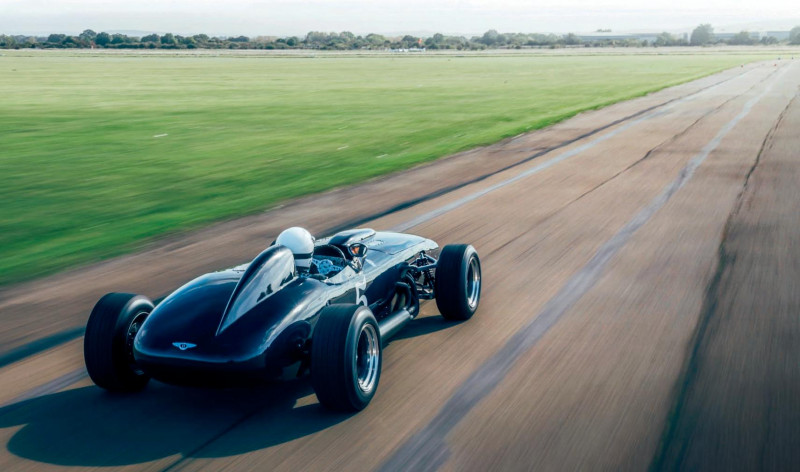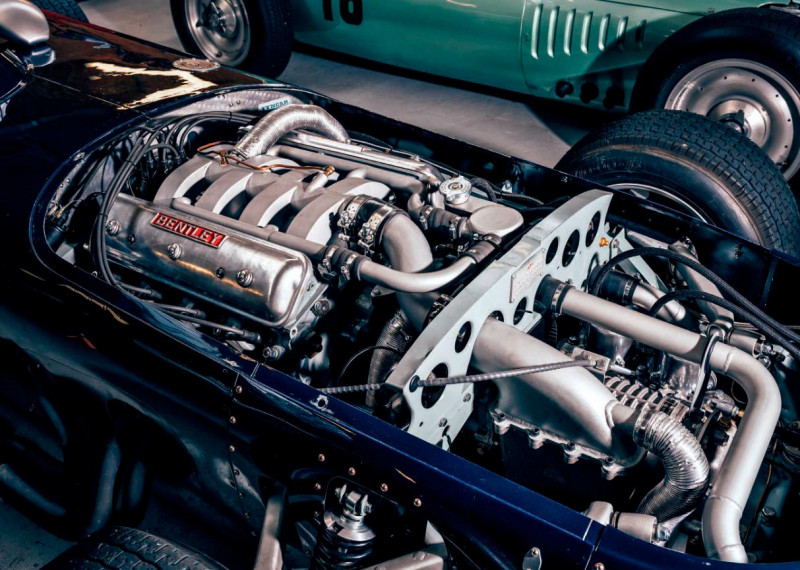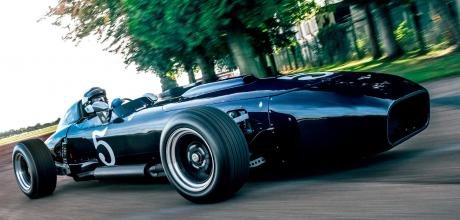Silver Shadow-based 1965 Bentley T-type Special
If you were going to build a single seater, you probably wouldn’t start with a Rolls-Royce Silver Shadow. But this unlikely old warhorse recently won its first race.
CREWE CUT
HEAVY METAL THUNDER
Paul Hardiman is bemused by the idea of a Silver Shadow-based Bentley racer
Don’t look at the gear gate,” shouts owner Ben Eastick over the exhausts. “The pattern is normal, but the gate’s back-to-front and it’ll just confuse you.” And he’s right. The last gearchange I experienced that demanded this much concentration – and respect, for its huge, weighty stick – was in a Scammell Explorer. Even a ‘WO’ Bentley’s right-handed four-speed is more instinctive. But once you learn to trust your intuition and thrust the lever where you want it, any nervousness recedes. It doesn’t feel as if there’s much synchromesh at play, but it’s better as it warms, still preferring a deliberate double-declutch down to second… just like a Scammell (or a WO Bentley, as it happens). Not that it matters much which ratio you select in this unique Bentley T-type Special.

With a near-flat torque curve that doesn’t so much peak as flatline at 400lb ft once you’re over about 1500rpm, and only c2425lb to propel including driver and fuel (it weighs 2236lb, just over a metric tonne), it is prodigiously fast in any gear. Rolls-Royce advised that its pushrod V8 shouldn’t be revved to more than 5000rpm – though it now runs custom-made solid lifters – but the telltale sits 1000pm lower, and that’s quite enough for our small test track, especially with the 2.88:1 diff. It’s a mild balancing act to get it off the line, because it doesn’t feel as if there’s much flywheel. Eastick says it’s much smoother since the blower was fitted, and here the low extra mass of its internals must help.
‘Just to complicate things, the Lyncar team decided to supercharge the car in the spirit of the “Blower” Bentleys Barry Eastick admired’

With a bit of heat in the works, it turns into quite a benign thing, though there’s always more than enough beans to light the rear tyres and squirrel the tail. It tracks nice and straight, and doesn’t dart about on turn-in or brakes. That may change, because Eastick plans to tune out the slight understeer with castor, camber and a little toe out, but the front doesn’t push wide as much as you’d expect from contemporary reports that finger-wagged over the weight of the blower up front. It worked for Birkin and Villiers, and that’s essentially the spirit Ben’s father Barry set out to recreate with this car.
“When my dad sold it I said: ‘One day I’m going to bring that back.’ This was the car of my childhood, and in nearly every period picture I’m there in the background”
Being brave, you can just about redline it in second on Bicester’s short straight, though experimentally using third – and then, once, fourth – reels in the line of cones at the end even faster, such is the torque. The brakes – standard Silver Shadow solid discs – squeal a little but pull straight and with enough bite not to unnerve you. It has run servos in the past, but really doesn’t need them. The steering is pleasantenough, lightening up as soon as you’re on the move. It now uses GM-sourced rack and pinion and no doubt would have been more vague with the old recirculating-ball system. Especially in the wet, as its originator found out.
Generally, it’s quite controllable – chuckable, even – with a few more laps to get some heat into the Dunlop Racers. Only after walking away do you realise that it reminds you of an enormous Caterham Seven – if you can imagine one on ’60s Formula One-sized wets (the same size as original GT40 rubber, as it happens). And therein lies the conundrum: it is pretty huge, although that’s accentuated by the long nose. Eastick points out that its footprint is just about the same as an old-style, Offenhauser-powered Indy racer but, given the choice, you probably wouldn’t start from here. The clue is in the chassis number, SSSC-2, which stands for ‘Silver Shadow Special Chassis 2’.

It all started in the early 1970s when Barry Eastick, a keen racer with the Bentley Drivers Club, wanted something to improve on his MkVI Special. He’d noticed the two prototype Silver Shadow/Bentley T1 chassis doing the rounds to promote Rolls-Royce’s revolutionary new saloon – with monocoque construction, independent suspension and discs all round – and cheekily asked if he might have one. The answer, incredibly, was yes, authorised from the very top by chairman Sir David Plaistow – though R-R, via marketing director John Craig, insisted on a hands-off approach. And £1100 inc VAT later Barrington R Eastick was the proud owner of a set of running gear, including the 6.2-litre aluminium V8.
The next issue was getting it built. He initially consulted with Alan Padgett, a well-known and respected specials builder who provided sketches clearly inspired by the Phil Scragg Lister-Jaguar ‘Monzanapolis’, but constructing it proved beyond home-building capabilities. So he turned to respected race-car constructor Lyncar, conveniently situated behind his sugar-processing factory in Slough and a stone’s-throw from where the Lola GT and GT40s were built, so he could easily keep an eye on the work. Lyncar essentially took the front and rear subframes and tied them together with box-section spaceframe longerons, keeping the double wishbones at the front and trailing arms at the rear, though suspended by conventional coil-overs rather than the self-levelling struts found in the saloon. The standard solid discs and calipers were retained, but without the Citroën-style high-pressure hydraulics, changed to a simple and conventional (in racing terms) dual-circuit system split front/rear, bias-adjustable via a balance bar between the master cylinders. There’s even a handbrake. And a horn…
Just to complicate things, the team decided to supercharge the car, in the spirit of the ‘Blower’ Bentleys that Eastick Snr so admired. “He wanted a vane-type blower,” son Ben confirms. The Wade unit sits in front of the engine, just as in the pre-war Amherst Villiers design, directly driven from the front of the crankshaft. That limits revs, and therefore boost, but there were 6.2 litres to play with, so it wasn’t considered to be too much of an issue. The compressor sucks through a pair of 2in SU carbs, just like a vintage ‘Blower’.
For the transmission, the close-ratio four-speed from a Bentley R-type Continental was selected, though in hindsight it would probably go just as well with a GM Hydramatic as fitted to post-’71 Shadows and Ts. This has to be inverted to bring the gearchange up on the left, leading to that reversed gate, but a pivoted linkage returns it to normal at the driver’s end of the lever.
Sorting the induction was one of the biggest headaches. Originally, Barry Eastick wanted to try injection or turbocharging, and even asked Mercedes for advice for the former. For the latter he was told that Crewe wasn’t sufficiently far down that road, though its efforts eventually resulted in the Mulsanne Turbo. Respectfully, I think the Easticks might have dodged a bullet there. The rest is conventional 1960s: the body is by Maurice Gomm and the wheels are Minilites, wearing Dunlop Racers.
Eastick Snr’s first time out was at BDC Silverstone in 1976, but the car broke its layshaft. He was back the following year, broke the BDC lap record and put it on pole… and then it rained. Slightly unpredictable steering from the original recirculating-ball set-up and a chassis that tended towards understeer did the rest. After the subsequent crash it was rebuilt without the blower and later Eastick even drove the car on the road, fitted with mudguards (rather fetching ’70s-style mouldings), lights and numberplates. “He would go off up the M4 to work with his briefcase,” remembers Ben. Then, in 1981, the Special was sold, and by ’94 it was in the USA. Ben takes up the story, his enthusiasm for the car shining through: “The original plan was to take the Bentley name back to Le Mans, and this was the first step. It really goes back to 1931, when Rolls-Royce bought Bentley and said that Bentleys would never race again. But various Bentley Drivers Club members felt strongly enough to keep the name alive in racing. It was a hugely complicated process, and that made my dad ill. When he sold it, I said: ‘One day I’m going to bring that back.’ This was the car from my childhood, and in nearly every period picture I’m there in the background.
“About 15 years ago it was for sale for $3m, but that would have meant selling my D-type, which I wasn’t prepared to do. Then four years ago I saw it on the internet. I knew where it was – I had been tracking it – and luckily Bob Halpern, who had owned it until 2007, hadn’t had the money to do much apart from a few concours events, and that’s what saved it. Eventually the owner said he would sell the car to me for what he paid for it.”
The car arrived back in the UK in March 2017 and went straight to Classic Performance Engineering at Bicester Heritage, which looks after Eastick’s Jaguar. “To start with, we just changed the fluids and got it running to be able to have a drive around on site,” says James Waddington, who did the recommissioning and restoration work. Eastick then competed at BDC Silverstone in August 2017 without the blower. He qualified second and led the first lap but, with the engine overheating, he finished fourth in the Bentley scratch race.
“In December we did some cold, wet-weather testing see how the original set-up worked, then stripped every nut and bolt,” says Waddington. “The suspension and safety-critical items were crack-tested and surface-finished. The wiring was completely replaced and the chassis painted, but the body wears its original Jaguar Midnight Blue paint. The Americans had put stickers down the sides, but luckily Richard Tipper of Perfection Valet was able to save the paintwork.”
CPE boss Martin Greaves adds: “The R-type gearbox has been the Achilles’ heel of Bentley Specials for decades because it was only designed to handle 200bhp. We rebuilt it but it failed as the lap times came down in testing before BDC Silverstone in 2019, and again a year later.
“We redesigned and remade the gears and shafts, and put on ‘handcuffs’ to keep the shafts together. Otherwise the immense torque forces them apart and it starts stripping gears.”
The engine was still the original development unit, which Eastick wanted to keep, so CPE engineered tie straps to strengthen the bottom of the block. The Roots-type Wade supercharger was the original and came back with the car from the USA, apart from one part of the inlet, subsequently found in late Lyncar boss Martin Slater’s garage in Wales. Waddington reinstalled the Ki-Gass system, a manual pump that injects a small amount of fuel into the intake instead of using a choke. The ‘Blower’ Bentleys of the ’30s used exactly the same system. “He didn’t know where to put it,” explains Eastick, “but the only place for it was on the transmission cover – which is exactly where it was originally.
“Once the supercharger was commissioned, we did development work on the SU carburettors to get the fuelling correct throughout the rev range, which involved turning down the carb needles to the correct profile. Barry and Lyncar never got to that development stage in period.” The rebuild also made it possible to incorporate rack-and-pinion steering for the first time. “Because Crewe was working with General Motors in the 1960s, it is a GM unit,” says Eastick, “which Barry intended to fit for the 1978 season but it never happened. The original, unassisted recirculating-ball steering was adapted for road use with a Jaguar servo, so the rack-and-pinion was never tested until now.”
It all worked: Eastick finally won the car’s first race, the BDC Times Trophy scratch race at the Bentley Drivers Club meeting in August 2021, vindicating his decision to keep the car at its original 6230cc, when upgunning it to 6750 would have been easy. “To top it all,” says Eastick, “it’s the only Bentley racer to have had Crewe’s blessing at the very highest level.”
Thanks to Classic Performance Engineering (classicperformanceengineering.co.uk); Scramblers (wearescramblers.com)
Ben Eastick pushes the unique Bentley racer towards its first win, at the BDC Times Trophy race at Silverstone in August 2021.
Huge performance from the supercharged V8 shrinks the already compact Bicester Heritage track.
Left: with lights and plates, the Special makes for an outrageous road car.
Below: Team Eastick, as mum Anne and Ben (6) chat to dad Barry at Silverstone. Left: Barry on pole for Times Trophy Bentley scratch race, ’77 Debut in ’76 with Ben, Lyncar’s Vernon Francis and tanker driver Ted Potter T-type wore Bentley grille until a BDC rule change in 1976.
Supercharger is driven directly from nose of crank, limiting revs and therefore boost.
Below: spacious cockpit with inverted R-type ’box.Body in build at Maurice Gomm’s workshop. Above: Rolls-Royce letter reveals rare decision to release a factory chassis, for £1100 in 1974 Padgett’s original sketches show the ambition to get the main weight as close as possible to the car’s centre line, and elegant proportions inspired by the Lister ‘Monzanapolis’


